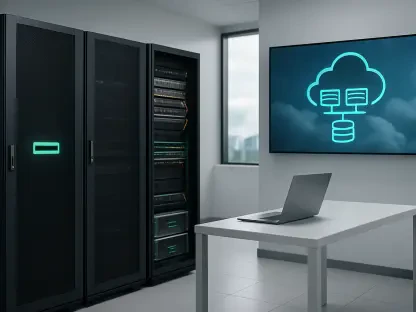For over two decades, virtualization has stood as a bedrock of enterprise IT, providing a reliable and almost invisible layer that powered data centers with efficiency and consistency, but now this once-steady foundation is trembling under the weight of dramatic shifts in licensing models, pricing structures, and vendor relationships, creating a phenomenon known as the Great Virtualization Reset. This upheaval is not a minor glitch but a profound transformation that compels businesses to reevaluate their entire IT strategies, particularly within hybrid cloud environments. Enterprises find themselves at a crossroads, grappling with unexpected costs and operational complexities while striving to maintain stability in an increasingly unpredictable landscape. Amidst this turmoil, Hewlett Packard Enterprise (HPE) steps forward with a compelling and pragmatic solution, offering a lifeline through its innovative portfolio. With a focus on flexibility and future-readiness, HPE is positioned as a leader in navigating this reset, providing businesses with a genuine alternative to traditional virtualization challenges.
Navigating a Disrupted Virtualization Landscape
The virtualization market, long considered a predictable cornerstone of enterprise IT, has been thrust into disarray by recent changes that have upended economic models and control mechanisms. IT leaders face disruptions in pricing strategies and vendor partnerships that directly impact budgets, compliance requirements, and staffing plans. Rather than seeking temporary fixes or complete system overhauls, companies are prioritizing a thoughtful modernization journey spanning the next three to five years. This approach must ensure operational continuity while steering clear of the pitfalls of vendor lock-in. HPE recognizes this critical need for a balanced strategy and has tailored its offerings to provide a stable path forward, addressing immediate uncertainties while laying a foundation for sustained growth in a shifting market.
Beyond the surface-level disruptions, enterprises are wrestling with deeper challenges that strike at the heart of their IT operations. Escalating costs tied to revised licensing structures have become a significant burden, often catching budgets off guard. Simultaneously, there is a pressing need to safeguard years of investment in automation tools and processes, ensuring that existing systems remain viable. Operational simplicity is another key demand, as businesses seek platforms that reduce complexity through unified management and automation, minimizing skills gaps among staff. Trust in partnerships has also taken on renewed importance following recent instability in the virtualization ecosystem, pushing companies to align with vendors who demonstrate reliability and long-term commitment to their success.
HPE’s Innovative and Modular Approach
In a market crowded with solutions that often lead to either restrictive hyperconverged infrastructure (HCI) setups or unsupported open-source chaos, HPE carves out a distinct path with a full-stack, modular ecosystem. This approach, often described as “integration without imposition,” empowers businesses to modernize on their own terms without the need to discard existing investments. HPE’s portfolio stands out by supporting mixed environments, allowing for a seamless blend of legacy and new technologies. This flexibility ensures that enterprises can adapt to the virtualization reset without being forced into rigid frameworks, positioning HPE as a trusted ally in a fragmented and uncertain landscape where adaptability is paramount.
Central to HPE’s strategy are three pivotal components designed to address diverse enterprise needs. HPE Alletra Storage MP, an all-flash, disaggregated storage platform, offers a scalable backbone for workloads ranging from AI data pipelines to virtual machine environments, while ensuring robust data security across multiple hypervisors. HPE Private Cloud Business Edition, driven by HPE Morpheus Software, serves as a sophisticated control plane, delivering orchestration and self-service capabilities through a unified console for hybrid infrastructure management. Complementing these is HPE Morpheus VM Essentials, a KVM-based virtualization platform that provides enterprise-grade functionality without the heavy licensing costs of traditional solutions, facilitating smooth workload migrations and operational efficiency.
Differentiating in a Competitive Arena
HPE’s approach sharply contrasts with the common alternatives in the virtualization space, where competitors often push HCI models that bundle compute and storage into inflexible packages, limiting scalability and choice. On the other end, unsupported do-it-yourself open-source options can lead to management nightmares, leaving enterprises vulnerable to operational risks. HPE avoids these extremes by delivering an engineered solution that balances integration with an open, modular architecture. This enables companies to capitalize on their current systems while streamlining management tasks and crafting a clear exit strategy from outdated technologies, all without unintended consequences or collateral disruptions to their IT environments.
Moreover, HPE’s vision transcends merely addressing virtualization challenges; it redefines the operational model for private cloud infrastructure. The current reset offers a unique opportunity to embrace cloud-like agility, maintain local control, and achieve cost transparency while extending capabilities to public cloud and edge scenarios. Through offerings such as the consumption-based HPE GreenLake Flex, HPE equips businesses to meet emerging demands like AI-driven workloads and stringent data sovereignty requirements. This forward-thinking stance ensures that enterprises are not just reacting to immediate pressures but are proactively building resilience for future technological shifts and market dynamics.
Shaping the Future of Hybrid Infrastructure
The Great Virtualization Reset marks a critical inflection point for enterprise IT, presenting not just a technical challenge but a strategic opportunity to rethink long-term goals. HPE’s comprehensive vision extends well beyond short-term fixes, aiming to construct a hybrid infrastructure model that harmonizes today’s operational needs with the innovations of tomorrow. By prioritizing customer choice and meeting businesses where they currently stand, HPE establishes itself as a dependable partner for both tactical transitions during turbulent times and ambitious growth strategies that look ahead to the evolving demands of the digital landscape.
This commitment is underpinned by a focus on operational simplicity, cost efficiency, and ecosystem reliability—principles that resonate deeply with enterprises navigating a market fraught with uncertainty. HPE’s integrated platform, combining cutting-edge storage, orchestration, and virtualization technologies, tackles the immediate disruptions in the virtualization space with remarkable clarity. Looking back, it becomes evident that HPE not only addressed these pressing issues but also set a new standard for private cloud operations. As businesses move forward, the path is clear: partnering with HPE means embracing a solution that turns a challenging reset into a powerful catalyst for transformation and sustained success.









